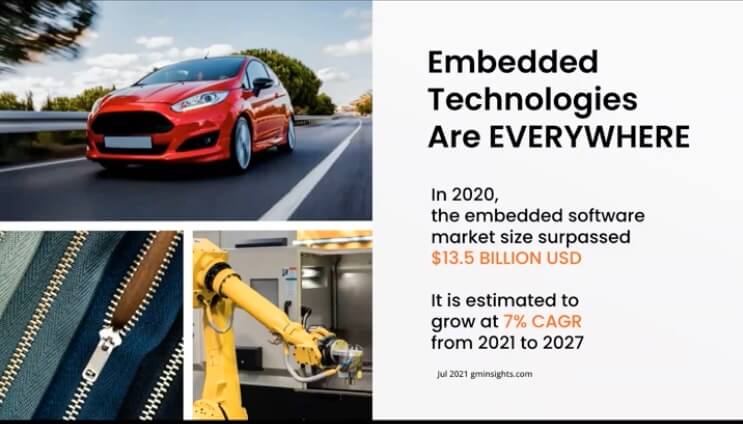My name is David Abramson. In this article, we're going to be talking about partnerships, specifically SaaS software, OEM, or embedded technology partnerships. In a nutshell, if you're looking for embedded technologies to integrate inside your software applications, you’ve come to the right place!
If that's not enough, I’m gonna give you seven awesome tips for selecting the right partners and vendors to work with. 💪
It can be a tricky topic, so let’s go back to basics first. Here’s a brief crash course on embedded technologies.
History of embedded technologies
Now, the truth is…👇

That’s right, everywhere! These embedded concepts have been around for quite some time and in all kinds of industries. Basically, anytime you're building a product, whether it's cars, clothing machines, or SaaS software products, there is an opportunity to partner with the best embedded tech solutions.
Not just that, there’s an opportunity to embed rich technology that can improve the product that you’re offering. In the software space, in particular, embedded technologies are really booming! This is an ever-growing industry, with the potential for more growth all the time.
At Qrvey services, we focus specifically on embedded software for analytics capabilities. This set of technologies can really be a powerful tool for improving and enhancing your product offerings.
Why embedded technologies?
As a software company, you've got teams of developers and engineers, So, let’s build everything in-house, right? That might be tempting. But in our experience, there are some really important benefits to embedded technologies, some of which are listed here. 👇

The benefit of time-saving
This is really the most crucial benefit. In a recent Nucleus research study, which focused on embedded analytics and their value, it was found that embedded software projects can go live in as little as three weeks when compared to building it yourself in-house. Sometimes it might take up to eight months or more for that fully home-built solution to be ready to go to market.
You might have heard the old saying: time is money. But it’s not just about the time that you're saving. It allows you to quickly take advantage of some other benefits. These could include:
- Offering some additional product differentiation,
- esponding faster to customer demands,
- boosting your customer satisfaction,
- and even creating new revenue streams and accelerating the growth of your business.
👆This last one is really the most essential. The faster you can do that, the bigger the benefit you're going to see.
These benefits matter
Now more than ever, these benefits are really important. Obviously, with the global pandemic impacting everything, including SaaS businesses, a recent report showed that 30% of SaaS companies are seeing higher churn rates in the past year.
You want to avoid churn wherever you can. It’s really important to figure out the best ways to respond to this. Avoiding churn can ensure you're continuing to grow your business. Another study from OpenView found that as many as 70% of respondents were being faced with some type of an incentive to try to stem that churn.
Yeah, I know this data can seem a bit alarming, but as product people, we’re always looking at ways that we can improve your products by looking for the best options.
What are we trying to achieve overall?
You should establish this right off the bat:
- Is it about differentiation?
- Is it more just feature expansion?
- Is it about building more capabilities on the roadmap?
- Maybe it’s about entering some new markets?
How do product managers typically choose partners?
As you’re just getting started in your journey, maybe you’re wanting to look at the greatest technology, or maybe you want to incorporate something that doesn't break the budget. That’s all fine and understandable. But there are some problems with these types of decisions.
The problem with shiny new things
The thing is, the hottest trends might generate a tonne of buzz, but they don't always solve the most vital customer problems that you might be facing. They don't always tackle those essential goals that come up as you’re getting started.
Stay alert! You might be adding technology that doesn't quite fit with your existing product. And it could be a mismatch in a number of different ways:
- Does it mismatch in look and feel?
- Is it the wrong tech stack entirely?
- Maybe your customers aren't even ready for it yet.
- Maybe it’s going to require some additional training or support that you just can't handle.
The problem with cheap things
The challenge with just finding the cheapest things is that you really have to be sure there aren’t any hidden costs. You don’t want any nasty surprises along the way.
Now, obviously, it’s understandable that you might be tempted to seek out the lowest price sort of offering. But there can be some hidden iceberg reasons for why something is cheaper. 👇

Ask yourself:
- Is there additional infrastructure to be implemented?
- Maybe it's a lot more work to do the integration?
- Maybe there's gonna be a lot less flexibility?
- Maybe the technology is antiquated, and that's why it costs less?
I want to zoom in on this last point for a second. Outdated technology is going to be a challenge when it comes to upgrades and future-proofing. Is it really cheaper if it isn’t going to give you longevity?
So, now that we’ve been through all the potential problems, let’s look at…
The better way to choose partners: seven steps
Okay, so this is kind of a no-brainer, but the first thing is, you really want to make sure you start with a good decision-making framework.
You can’t get started without a good plan. But what does a good framework actually look like? Well, you want to establish some type of scorecard that will list your criteria for a good partnership. Now, you might be tempted to just build that scorecard based solely on the technology, the features, and functionality, etc.
But it’s essential to make sure that you also include criteria outside of the technology. It has to include, for example, the company detail and information business model, and lots of other criteria. But what are the criteria for selecting the right type of partners?
Who are these guys?
This could really be as simple as:
- What is their background?
- Do they have experience in this technology space?
- What is their process? How responsive are they during the steps of your process?
Finally, what is their focus? Are they focused on offering embedded software? Or is that more of an afterthought for their business. It's essential to have that background information before moving forward to the next stages of the process of selecting a good partner.
Is their technology future-proof?
This really isn’t about features and functions, exclusively. Obviously, that's going to be a core component of any evaluation. You want to make sure you're getting the right features. But the real question to ask is, will the technology grow with you? In other words, is it future-proof?
The focus here can be more on architecture, as well as features.
- Is it built to scale?
- Does it run modern services?
- Does it offer the type of growth that you're going to need?
It has to be the right fit not just now and today, but moving forward for the future. Are we looking at longer-term solutions and customer-facing capabilities that are going to help you grow your business?
Do they really know embedded systems?
Another point to make is, is it really built to be embedded? This one is particularly important because after all, it’s something that's going to be an integral part of your product. You want to make sure that the vendor or partner that you're working with really has that focus on embedded technology.
- Does it integrate the right way?
- Is the technology the right fit for the use case?
- Do you actually even have visibility into their roadmap? Do you know what to expect moving forward?
- How are you going to grow your product around these embedded capabilities?
These are all incredibly important features that you should be looking for when you're selecting the vendor that you want to work with throughout this process.
What do other people say?
Are you carrying out proper background checks on the vendor?
What are other customers saying about them? This is really a great opportunity to talk to their existing customers, especially if it’s somebody in a similar industry. It's always important to find a comparable company or comparable use cases.
Here are some of the criteria you want to get to grips with:
- What are the positives?
- What are some of the negatives?
- What are the challenges?
- What can you expect in terms of timelines?
These are things that you can get from just talking directly to the vendor, but also talking to some of their other customers. Why not look to review sites?
Those are great resources to understand what other people are saying about the vendors or the product companies that you're working with. This can help you to get a big-picture look to understand how to make the right decision when you're choosing the partners to work with.
Will their licensing hold us back?
When you're looking at embedding technologies, you have to ask yourself, is the licensing going to cause problems? Is it something that’s actually going to be easy to use or is it going to be tied to some type of metric that doesn't work for your business?
You don't want to work with a vendor whose software is going to end up discouraging your user adoption. Maybe it's a user license that just won't work for your business. The license model needs to be built for embedding. Not just that, it has to be built for your use case.
Is their support adequate for our specific needs?
Think about whether their support system is going to meet your specific needs.
- Do they have experience with your frameworks, your technologies, your use case?
- Are they going to be able to solve your problems?
- What does good support look like for you?
- What types of offerings do they have?
- Does it match your customers’ expectations?
All those different things are going to make it possible for you to work with a company long term, and select the best partnership moving forward.
Are we ready to make a decision?
The final point is simple but really important. Quite simply, is your organization ready to make the decision? For this, you might need to take a step back and think about your decision-making process. Have you spent time with the right stakeholders in the organization?
We're talking about embedding technology into software products. So, there's gonna be stakeholders across all different departments of your organization. It’s so important to ensure that everybody is on board with that process. The more you can organize and get ready to make a decision, the better and more smoothly this process will go.
Key takeaways
So, to finish off here, let’s just go through a quick breakdown of our key talking points:
1. Make sure you have a scorecard or plan for your evaluation criteria and stick with it.
2. Focus outside of the tech when it comes to suitability. Look at business and company focuses when judging a potential partner.
3. Embedding technologies can reduce time spent, which often equates to money spent.
4. Finally, and perhaps most crucial of all, embedding technologies can reduce the churn rate.
But these benefits don’t count for anything unless you have the appropriate criteria to judge a potential partnership. I hope I’ve given you some useful criteria to add to your scorecard. It’s not an easy process, but it’s worth it. Have fun!



 Follow us on LinkedIn
Follow us on LinkedIn



